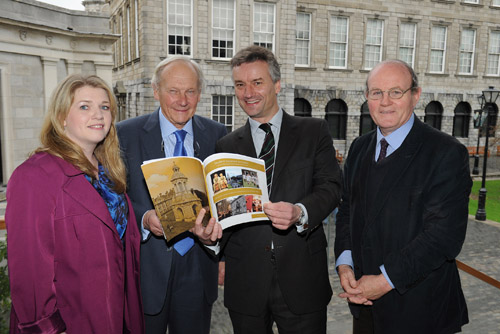Report on Trinity’s Student Societies and Clubs Launched
Posted on: 10 November 2011
A major new report on the current structures and historical context of student societies and clubs at Trinity College Dublin was launched recently by Provost Dr Patrick Prendergast. The report provides a broad view of the benefits that can result from involvement in student societies and clubs, and highlights how that involvement can positively affect the student experience. It was written by research fellow at the Trinity Long Room Hub, Dr Johanna Archbold and Professor of Economics at the School of Social Sciences and Philosophy, Dr John O’Hagan.
The book reviews the historical development of societies and clubs in Trinity College Dublin and the authors divide this history into four periods: the Early Years to 1800, 19th Century, 20th Century to 1960, and Recent Decades. According to the report, sports facilities developed in the College from 1650, with one of the earliest being a ‘tennis court’ situated near New Square. The oldest of the official sports clubs dates from the 19th century and they had a major influence on Irish sport in those years, particularly in cricket, rugby, rowing and athletics.

Johanna Archbold, John Pearson of J-P Foundation London, Provost Dr Patrick Prendergast and Professor of Economics John O’Hagan.
The last quarter of the 18th century was a golden age for Irish eloquence with Edmund Burke being perhaps the most famous of the great orators of this period. The formation of the College Historical Society in 1770, the first truly independent College society, was created out of Burke’s earlier club founded in 1747. Robert Emmet and Thomas Moore were early members of the Historical Society. The Phil has a loose connection to the early Dublin Philosophical Society, founded in 1683, but only became an official College society in 1843. Famous former members include Bram Stoker, Oscar Wilde, John B. Yeats, David Norris and Paddy Cosgrave, founder of the recent very successful Dublin Web summit.
The report demonstrates that the early history of clubs and societies shaped the structure of modern day societies and clubs at Trinity. While a huge number of new societies and clubs were added in the 20th century, the long-established societies and clubs still hold a very prominent place in the Trinity of 2011. Major changes in wider society have been reflected in the establishment of new clubs and societies. The admission of women into Trinity in 1904 was a significant development on campus, though it was not until the 1960s that many societies allowed them full membership. Political and cultural movements such as the Gaelic revival were also reflected in student clubs and society activities. Increased student numbers, diverse backgrounds and new interests have also led to many other new societies.
In the arts and cultural area, the focus of a large part of this study, the long-established societies also still hold a prominent position. The Choral society has the most distinguished history of these societies. Founded in 1837 it had a pivotal role in the Dublin social calendar throughout the 19th century with a number of their annual concerts attracting audiences of 2000-3000 spectators. Apart from the Choral society, Players has played a very important role for almost 80 years in the College. The same applies for almost 50 years to the Arts Workshop, the Visual Arts Society, the Literary Society and the Photographic Society and several literary publications. But many new student music societies have been formed in this time, the Orchestral Society being particularly successful in recent years. The College now also boasts radio, video, digital arts and TV societies.
Commenting on the report the authors said: “Societies and clubs align the student experience with John Henry Newman’s oft-cited and influential lecture ‘the Idea of a University’ which highlighted the value of the broadest possible tertiary education. The activities of the societies can also represent a link between students and academic departments. As the activities of many of these societies are also open to the public, they can act as an additional tie between Trinity and the city, for example the annual Trinity Shakespeare Festival.”
The authors continue: “Trinity must adapt to changing circumstances, and yet not lose the benefits of its history in relation to student societies and clubs. The innovation and energy that led to the creation of the College’s fine historic societies and clubs must be renewed, to both maintain what is good from the past and to meet new challenges and student preferences.”
The book was funded by the J-P Foundation, London.
